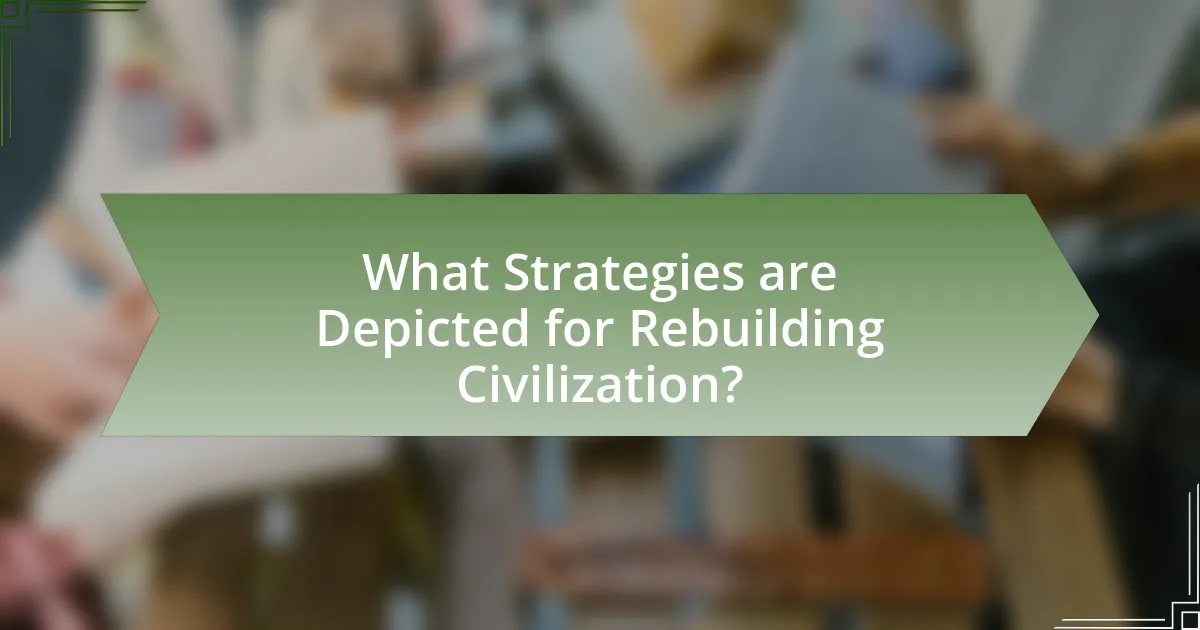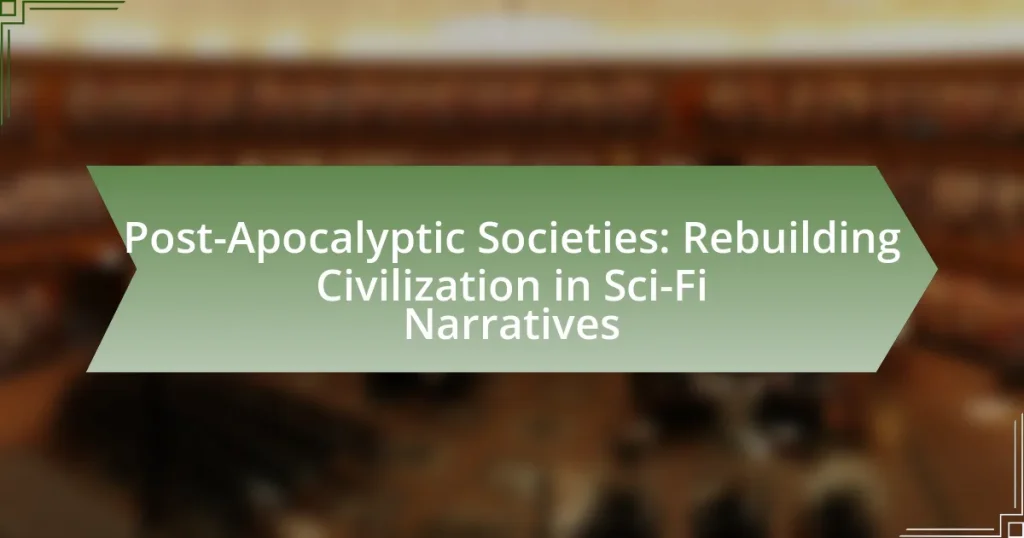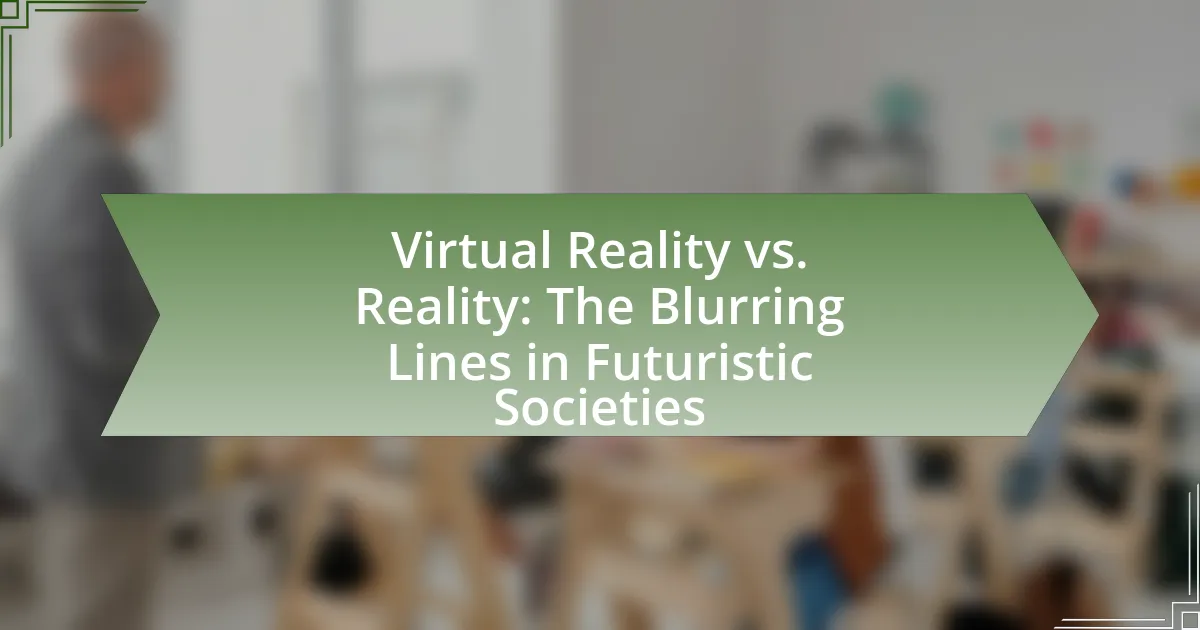Post-apocalyptic societies in sci-fi narratives are communities that arise following catastrophic events, such as nuclear war, pandemics, or environmental disasters, leading to the collapse of civilization. These societies face challenges related to resource scarcity, the redefinition of social structures, and the emergence of new governance systems. The article explores how these societies form, the events that lead to their creation, and the characteristics that define them, including survival strategies, moral dilemmas, and the role of technology. Additionally, it examines the evolution of relationships, cultural practices, and the lessons that can be learned from these narratives, providing insights into resilience and community rebuilding in real-world contexts.

What are Post-Apocalyptic Societies in Sci-Fi Narratives?
Post-apocalyptic societies in sci-fi narratives are communities that emerge after a catastrophic event, such as nuclear war, pandemics, or environmental collapse, which devastates civilization. These societies often grapple with the remnants of technology, struggle for resources, and redefine social structures in the absence of established governments. For example, in Cormac McCarthy’s “The Road,” survivors navigate a bleak landscape while forming new familial bonds, illustrating the human instinct to connect despite dire circumstances. Such narratives frequently explore themes of survival, morality, and the resilience of the human spirit, reflecting societal fears and hopes in the face of potential global crises.
How do these societies emerge in fictional worlds?
Societies in fictional worlds, particularly in post-apocalyptic narratives, emerge through a combination of catastrophic events and the subsequent human response to survival and rebuilding. These societies often form as a reaction to disasters, such as nuclear war, pandemics, or environmental collapse, which disrupt existing social structures and force individuals to adapt to new realities.
For instance, in the novel “The Road” by Cormac McCarthy, the collapse of civilization leads to the emergence of small, nomadic groups that prioritize survival over previous societal norms. This illustrates how the need for safety and resources drives the formation of new social orders. Additionally, in “Mad Max: Fury Road,” the scarcity of water and fuel creates a hierarchy based on control of these resources, demonstrating how environmental factors shape societal structures.
The emergence of these societies is often characterized by the establishment of new governance systems, cultural practices, and social hierarchies that reflect the values and necessities of the post-apocalyptic environment.
What events typically lead to the apocalypse in these narratives?
Events that typically lead to the apocalypse in these narratives include nuclear war, pandemics, environmental disasters, and technological failures. For instance, nuclear war often results in widespread destruction and radiation, as depicted in works like “On the Beach” by Nevil Shute. Pandemics, such as in “The Stand” by Stephen King, illustrate how a virus can decimate populations and disrupt societal structures. Environmental disasters, like climate change or asteroid impacts, are central to narratives such as “The Road” by Cormac McCarthy, where the aftermath of ecological collapse is explored. Technological failures, including artificial intelligence uprisings, are highlighted in stories like “Terminator,” showcasing the potential dangers of unchecked technological advancement. These events serve as critical turning points that reshape civilization and set the stage for post-apocalyptic societies.
How do different genres portray the apocalypse?
Different genres portray the apocalypse through distinct thematic lenses and narrative techniques. Science fiction often explores technological failures or alien invasions leading to societal collapse, as seen in works like “The War of the Worlds” by H.G. Wells, which depicts humanity’s struggle against extraterrestrial forces. In contrast, horror genres emphasize psychological terror and survival, exemplified by films like “The Road,” where the focus is on human depravity and moral dilemmas in a desolate world. Fantasy genres may present apocalyptic scenarios as battles between good and evil, such as in “The Dark Tower” series by Stephen King, where the end of the world is tied to metaphysical conflicts. Each genre thus reflects unique cultural anxieties and philosophical questions surrounding the end of civilization.
What characteristics define post-apocalyptic societies?
Post-apocalyptic societies are characterized by a breakdown of social order, scarcity of resources, and a struggle for survival. These societies often emerge after catastrophic events, such as nuclear war, pandemics, or environmental disasters, leading to a collapse of government and infrastructure. The absence of law and order results in the rise of new power structures, often based on tribalism or authoritarianism. Additionally, individuals in these societies frequently face challenges such as limited access to food, clean water, and medical care, which further exacerbates conflict and competition among groups. Historical examples, such as the aftermath of World War II in Europe, illustrate how societies can be reshaped by such crises, leading to significant changes in social dynamics and governance.
How do social structures change after an apocalypse?
Social structures undergo significant transformation after an apocalypse, often shifting from complex, hierarchical systems to simpler, more egalitarian forms. In the aftermath of catastrophic events, survival becomes the primary focus, leading to the formation of small, tight-knit communities that prioritize cooperation and resource sharing. Historical examples, such as the societal changes observed after the fall of the Roman Empire, illustrate how centralized authority diminishes, resulting in localized governance and communal decision-making. Additionally, the breakdown of traditional social roles occurs, as individuals adapt to new realities, often leading to a redefinition of gender roles and labor distribution based on necessity rather than societal norms. These changes reflect a fundamental shift in human interaction, emphasizing resilience and adaptability in the face of adversity.
What role does technology play in these societies?
Technology serves as a crucial tool for survival and rebuilding in post-apocalyptic societies. In these narratives, technology often represents the remnants of a lost civilization, providing essential resources for food production, communication, and defense against threats. For instance, characters may utilize solar panels or wind turbines to generate electricity, highlighting the importance of renewable energy sources in a resource-scarce environment. Additionally, advanced technologies like robotics or artificial intelligence can assist in reconstruction efforts, as seen in various sci-fi works where automated systems help restore infrastructure. The presence of technology not only facilitates survival but also symbolizes hope for a future where civilization can be rebuilt, as evidenced by the recurring theme of rediscovering and repurposing old technologies to create new societal structures.
Why are these narratives significant in contemporary literature?
Post-apocalyptic narratives are significant in contemporary literature because they explore themes of survival, resilience, and the human condition in extreme circumstances. These narratives often reflect societal anxieties about current global issues such as climate change, pandemics, and political instability, allowing readers to confront their fears and consider the implications of societal collapse. For instance, works like “The Road” by Cormac McCarthy illustrate the struggle for hope and humanity in a desolate world, emphasizing the importance of relationships and moral choices. This relevance to contemporary issues and the exploration of fundamental human experiences make post-apocalyptic narratives a vital part of modern literary discourse.
How do they reflect societal fears and hopes?
Post-apocalyptic narratives reflect societal fears and hopes by illustrating the consequences of human actions and the potential for renewal. These stories often depict fears related to environmental collapse, nuclear war, or societal breakdown, showcasing the fragility of civilization and the chaos that can ensue. For instance, films like “Mad Max” highlight fears of resource scarcity and societal decay, while simultaneously presenting characters who embody resilience and the hope for a better future. This duality serves to mirror real-world anxieties about climate change and geopolitical instability, while also inspiring optimism about human adaptability and the possibility of rebuilding.
What themes are commonly explored in these stories?
Common themes explored in post-apocalyptic stories include survival, human resilience, societal reconstruction, and moral dilemmas. These narratives often depict characters facing extreme challenges that test their ability to adapt and rebuild in the aftermath of catastrophic events. For instance, the theme of survival is prevalent as characters navigate scarce resources and hostile environments, while human resilience is highlighted through their determination to overcome adversity. Societal reconstruction is frequently examined, showcasing the complexities of establishing new social orders and governance structures. Additionally, moral dilemmas arise as characters confront ethical choices in a lawless world, reflecting on the nature of humanity and civilization.

How do Characters Navigate Post-Apocalyptic Worlds?
Characters navigate post-apocalyptic worlds by employing survival skills, forming alliances, and adapting to new environments. They often rely on resourcefulness to scavenge for food, water, and shelter, which is crucial in a landscape stripped of societal norms and infrastructure. For instance, in many narratives, characters demonstrate adaptability by learning to utilize remnants of technology or nature to meet their needs. Additionally, the formation of social groups or communities is common, as collaboration enhances survival chances against threats, whether from other survivors or environmental dangers. This dynamic is evident in works like “The Road” by Cormac McCarthy, where the protagonists’ journey emphasizes the importance of companionship and moral choices in a desolate world.
What types of characters are commonly found in these narratives?
Commonly found characters in post-apocalyptic narratives include survivors, leaders, scavengers, and antagonists. Survivors often embody resilience and adaptability, navigating the challenges of a devastated world. Leaders typically emerge to guide communities, making critical decisions for survival and rebuilding. Scavengers represent resourcefulness, often searching for supplies in the remnants of the old world. Antagonists, such as raiders or oppressive regimes, create conflict and highlight the struggle for power and resources. These character types are essential for exploring themes of survival, morality, and the human condition in the aftermath of societal collapse.
How do protagonists differ from antagonists in these settings?
Protagonists in post-apocalyptic societies typically embody hope, resilience, and the drive to rebuild civilization, while antagonists often represent despair, chaos, and the desire to maintain or exploit the existing disorder. Protagonists are usually characterized by their moral compass and willingness to collaborate with others for a common good, as seen in narratives like “The Road” by Cormac McCarthy, where the father strives to protect his son and uphold humanity’s values. In contrast, antagonists may exploit the breakdown of societal norms for personal gain, as illustrated by characters in “Mad Max: Fury Road,” who thrive on violence and anarchy. This dichotomy highlights the fundamental conflict between the forces of reconstruction and destruction in these narratives.
What roles do supporting characters play in rebuilding efforts?
Supporting characters play crucial roles in rebuilding efforts within post-apocalyptic societies by providing emotional support, diverse skill sets, and facilitating social cohesion. These characters often embody various perspectives and experiences that contribute to problem-solving and resource management, essential for survival and reconstruction. For instance, in narratives like “The Road” by Cormac McCarthy, supporting characters help to illustrate the complexities of human relationships in dire circumstances, emphasizing the importance of collaboration and trust in rebuilding communities. Their interactions often highlight the necessity of teamwork and shared goals, which are vital for effective recovery and the establishment of a new societal structure.
How do characters adapt to their new environments?
Characters adapt to their new environments by developing survival skills, forming alliances, and altering their behaviors to meet the challenges posed by their surroundings. In post-apocalyptic narratives, characters often learn to scavenge for resources, navigate dangerous landscapes, and utilize technology or knowledge from the past to enhance their chances of survival. For instance, in “The Road” by Cormac McCarthy, the protagonists adapt by relying on each other for emotional support and practical survival strategies, showcasing the importance of human connection in harsh conditions. This adaptability is crucial for their survival and reflects the broader theme of resilience in the face of adversity.
What survival skills are emphasized in these stories?
The survival skills emphasized in post-apocalyptic stories include resourcefulness, adaptability, and self-sufficiency. Characters often demonstrate the ability to find food and water, create shelter, and defend themselves against threats, showcasing their ingenuity in dire situations. For instance, in narratives like “The Road” by Cormac McCarthy, the protagonists must scavenge for supplies and navigate a hostile environment, highlighting the importance of survival tactics in extreme circumstances. These skills are critical for navigating the challenges of a collapsed society, as they enable individuals to sustain themselves and rebuild civilization.
How do relationships evolve in the face of adversity?
Relationships evolve in the face of adversity by fostering deeper connections and resilience among individuals. In post-apocalyptic societies, shared challenges often lead to increased cooperation and trust, as people rely on one another for survival. For instance, studies show that groups facing significant stressors, such as natural disasters or societal collapse, tend to form stronger social bonds, as evidenced by the formation of support networks and communal living arrangements. This evolution is characterized by a shift from individualism to collectivism, where the survival of the group becomes paramount, thereby enhancing interpersonal relationships and creating a sense of belonging amidst chaos.
What moral dilemmas do characters face in post-apocalyptic societies?
Characters in post-apocalyptic societies face moral dilemmas such as the choice between survival and ethics, loyalty versus betrayal, and the value of human life versus resources. These dilemmas arise from the collapse of societal norms, forcing individuals to make decisions that challenge their moral compass. For instance, characters may struggle with the decision to steal food to survive, which conflicts with their moral beliefs about property rights. Additionally, loyalty to a group may lead to betrayal of others, as seen in narratives where alliances shift for survival. The scarcity of resources often leads to the question of whether to sacrifice one person for the greater good, highlighting the tension between individual rights and collective survival. These moral conflicts are central to the narrative tension in post-apocalyptic stories, illustrating the complexities of human behavior in extreme circumstances.
How do choices impact the rebuilding of civilization?
Choices significantly impact the rebuilding of civilization by determining the allocation of resources, governance structures, and social norms. For instance, decisions made by leaders regarding resource distribution can either foster cooperation or lead to conflict among survivors, as seen in various post-apocalyptic narratives like “The Road” by Cormac McCarthy, where scarcity drives moral dilemmas. Furthermore, choices about governance, such as establishing democratic versus authoritarian systems, shape societal stability and individual freedoms, influencing long-term recovery. Historical examples, such as the rebuilding of Europe after World War II, illustrate that strategic choices in economic policies and international cooperation can lead to rapid recovery and growth, reinforcing the critical role of decision-making in the reconstruction of societies.
What ethical questions arise regarding leadership and governance?
Ethical questions regarding leadership and governance in post-apocalyptic societies include the legitimacy of authority, the balance between individual rights and collective security, and the moral implications of resource allocation. Leaders must justify their power, often derived from survival needs, which can lead to authoritarianism or exploitation. The necessity of prioritizing community welfare may conflict with personal freedoms, raising dilemmas about consent and autonomy. Additionally, decisions on resource distribution can create inequalities, prompting questions about fairness and justice in a context where survival is paramount. These ethical considerations are critical in shaping the governance structures that emerge in such narratives.

What Strategies are Depicted for Rebuilding Civilization?
Strategies depicted for rebuilding civilization in post-apocalyptic narratives often include establishing sustainable agriculture, forming new governance structures, and fostering community cooperation. Sustainable agriculture is crucial as it ensures food security and resource management, often illustrated through the cultivation of resilient crops and permaculture practices. New governance structures emerge to replace failed systems, focusing on decentralized decision-making and local leadership, which enhances adaptability and responsiveness to community needs. Community cooperation is emphasized as individuals unite to share resources, skills, and knowledge, creating a sense of solidarity essential for survival and rebuilding. These strategies are frequently showcased in various sci-fi works, highlighting their importance in the recovery and growth of societies after catastrophic events.
How do communities organize themselves after an apocalypse?
Communities organize themselves after an apocalypse by establishing leadership structures, creating resource-sharing systems, and forming social bonds for mutual support. Leadership often emerges from individuals with survival skills or prior authority, guiding decision-making and conflict resolution. Resource-sharing systems are crucial, as communities prioritize food, water, and shelter distribution to ensure survival. Social bonds develop through shared experiences and collaborative efforts, fostering a sense of belonging and cooperation. Historical examples, such as the aftermath of the fall of the Roman Empire, illustrate how communities adapted by forming local governance and trade networks to rebuild and sustain themselves.
What forms of governance are explored in these narratives?
The narratives exploring post-apocalyptic societies often depict various forms of governance, including authoritarian regimes, tribal systems, and democratic assemblies. For instance, in “The Road” by Cormac McCarthy, the absence of structured governance leads to survivalist tribalism, where power dynamics are dictated by brute force and resource control. Conversely, in “The 100” series, a council-based governance emerges, reflecting democratic principles as survivors attempt to rebuild society through collective decision-making. These examples illustrate how different governance structures are shaped by the challenges and circumstances of a post-apocalyptic environment.
How do resource management and distribution work in these societies?
Resource management and distribution in post-apocalyptic societies often rely on localized systems that prioritize survival and sustainability. These societies typically implement bartering systems, where goods and services are exchanged directly, minimizing reliance on currency that may no longer hold value. For instance, in many narratives, communities form cooperative groups to share resources like food, water, and shelter, ensuring equitable access among members.
Additionally, leaders or councils often emerge to oversee resource allocation, making decisions based on immediate needs and long-term viability. This approach is evident in various sci-fi narratives, where characters must navigate limited supplies and prioritize essential resources for survival. The effectiveness of these systems is often highlighted through the depiction of conflicts over resources, illustrating the challenges and strategies involved in managing scarcity.
What role does culture play in the rebuilding process?
Culture plays a crucial role in the rebuilding process by providing a shared identity and values that unify individuals in post-apocalyptic societies. This shared cultural framework fosters social cohesion, enabling communities to collaborate effectively in reconstruction efforts. For instance, in various sci-fi narratives, such as “The Road” by Cormac McCarthy, cultural elements like storytelling and rituals help maintain hope and a sense of purpose among survivors, facilitating emotional healing and collective action. Additionally, cultural practices can guide decision-making and resource allocation, ensuring that rebuilding efforts align with the community’s historical context and moral beliefs, as seen in “Station Eleven” by Emily St. John Mandel, where the preservation of art and performance becomes central to the community’s identity and resilience.
How do traditions and beliefs influence societal norms?
Traditions and beliefs significantly shape societal norms by establishing shared values and behaviors that guide community interactions. In post-apocalyptic societies, these traditions often emerge from the remnants of pre-collapse cultures, influencing how individuals perceive morality, authority, and social roles. For instance, in many narratives, the belief in communal survival fosters norms around cooperation and resource sharing, as seen in works like “The Road” by Cormac McCarthy, where characters rely on mutual support to navigate a harsh environment. Additionally, traditions may dictate rituals or practices that reinforce group identity, such as storytelling or memorializing the past, which can help maintain social cohesion in the face of adversity.
What forms of art and expression emerge in these settings?
In post-apocalyptic societies depicted in sci-fi narratives, forms of art and expression such as graffiti, music, storytelling, and visual arts emerge as vital means of communication and cultural preservation. Graffiti often serves as a form of protest or a way to convey messages about survival and identity, reflecting the struggles and resilience of the community. Music becomes a tool for emotional expression and social bonding, often incorporating themes of loss and hope. Storytelling, whether oral or written, plays a crucial role in passing down knowledge and experiences, helping to shape the new cultural identity. Visual arts, including painting and sculpture, often utilize found materials, symbolizing resourcefulness and creativity in the face of adversity. These forms of expression not only document the human experience in a changed world but also foster a sense of community and continuity amidst chaos.
What lessons can be learned from post-apocalyptic narratives?
Post-apocalyptic narratives teach critical lessons about resilience, human nature, and the importance of community. These stories often illustrate how individuals and societies adapt to extreme circumstances, highlighting the capacity for survival and innovation in the face of adversity. For instance, in Cormac McCarthy’s “The Road,” the bond between father and son emphasizes the significance of hope and moral choices even when civilization has collapsed. Additionally, these narratives frequently explore themes of resource scarcity and environmental degradation, prompting reflections on sustainability and the consequences of human actions. By examining the dynamics of power and cooperation in these fictional worlds, readers gain insights into the necessity of collaboration and empathy for rebuilding society after catastrophic events.
How can these stories inform real-world resilience strategies?
Stories of post-apocalyptic societies can inform real-world resilience strategies by illustrating adaptive behaviors and community rebuilding efforts in the face of catastrophic events. For instance, narratives often showcase the importance of resourcefulness, collaboration, and innovation, which are critical in real-life disaster recovery. Research indicates that communities that foster strong social networks and engage in collective problem-solving are more resilient to crises, as seen in studies by Norris et al. (2008) in “Community Resilience as a Metaphor,” which emphasizes the role of social capital in recovery. These fictional accounts can serve as case studies, highlighting successful strategies such as decentralized governance, sustainable resource management, and psychological resilience, which can be applied to enhance preparedness and response in actual disaster scenarios.
What best practices can be derived for community rebuilding?
Best practices for community rebuilding include fostering collaboration, establishing clear communication, and prioritizing resource management. Collaboration among community members enhances trust and collective problem-solving, as evidenced by successful recovery efforts in post-disaster scenarios like Hurricane Katrina, where community-led initiatives significantly improved resilience. Clear communication ensures that all members are informed and engaged, which is crucial for maintaining morale and unity; studies show that communities with effective communication strategies recover faster. Prioritizing resource management, including food, water, and shelter, is essential for sustainability, as demonstrated by the successful agricultural practices adopted in the aftermath of the Dust Bowl in the 1930s, which helped communities thrive despite harsh conditions.




